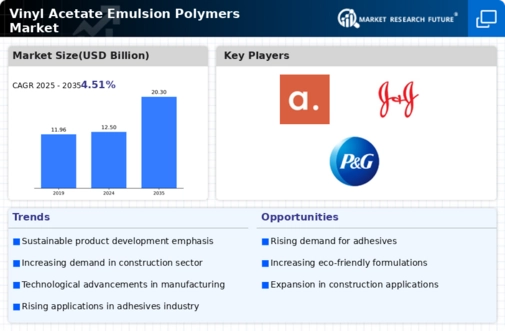Market Trends
Key Emerging Trends in the Vinyl Acetate Emulsion Polymers Market
The market trends of vinyl acetate emulsion polymers have experienced notable shifts, driven by a combination of industry dynamics and evolving consumer preferences. Vinyl acetate emulsion polymers find extensive applications in diverse sectors, including adhesives, paints and coatings, textiles, and paper. One prominent trend influencing the market is the increasing focus on sustainability and eco-friendly products. With growing environmental consciousness, there is a rising demand for vinyl acetate emulsion polymers that not only offer high performance but also comply with stringent environmental regulations. This trend has led to the development of water-based formulations, aligning with the global push to reduce volatile organic compound (VOC) emissions in various industries.
In response to the sustainability trend, manufacturers are investing in research and development to create vinyl acetate emulsion polymers with reduced environmental impact. Waterborne formulations, which incorporate these emulsion polymers, are gaining traction due to their lower VOC content and environmentally friendly profile. This shift is transforming the landscape of the market as companies strive to meet the demand for green and sustainable products, catering to consumers who prioritize eco-conscious choices.
Customization and innovation are also shaping the market for vinyl acetate emulsion polymers. Industries are increasingly seeking tailored solutions to meet specific application requirements. This demand for customization is driving manufacturers to invest in advanced technologies and formulations that enhance the versatility and performance of vinyl acetate emulsion polymers. Collaborative efforts between manufacturers and end-users are becoming more prevalent, fostering the development of specialized products that address unique challenges across various industries.
Globalization is another key factor influencing market trends, as the demand for vinyl acetate emulsion polymers is not confined to specific regions. Manufacturers are strategically expanding their product portfolios and geographic reach to stay competitive in the global market. Collaborations, mergers, and acquisitions are becoming common strategies to strengthen market presence and address the diverse needs of a global customer base. This globalization trend is reshaping supply chains and driving the industry towards increased efficiency and competitiveness.
The market for vinyl acetate emulsion polymers is also witnessing significant growth in emerging industries, particularly in the construction sector. The use of these polymers in adhesives, sealants, and construction materials has surged, driven by the booming construction activities worldwide. The versatility of vinyl acetate emulsion polymers makes them suitable for a wide range of applications within the construction industry, further fueling market expansion.
Despite these positive trends, challenges persist in the vinyl acetate emulsion polymers market. Fluctuations in raw material prices, particularly those related to petrochemical feedstocks, can impact production costs and subsequently influence market dynamics. Additionally, stringent regulations governing chemical safety and environmental compliance present challenges for manufacturers. Adhering to these regulations requires ongoing investments in research and development to ensure product formulations meet the necessary standards.






Leave a Comment